
Data Handling - Exercise-wise Questions and Answers For Class 2 Maths - Free PDF Download
This chapter introduces young learners to the basics of data handling, focusing on how to collect, organise, and interpret data in simple ways. NCERT solutions for Class 2 Maths chapter 11, Vedantu provides clear explanations and practical exercises to help students understand these concepts effortlessly.
 Table of Content
Table of ContentThese solutions are aligned with the CBSE Class 2 Maths syllabus, ensuring that students are well-prepared for their exams. For additional support, you can also explore NCERT solutions for Class 2 to build a strong foundation in mathematical concepts.
Glance on Class 2 Maths Chapter 11 - Data Handling
NCERT Solutions for Class 2 Maths Chapter 11 explains how to collect and organise information in a simple manner.
It teaches how to gather data through counting and observing everyday items.
This chapter explains how to arrange data in lists and tables to make it easier to understand.
These solutions also introduce tally marks as a way to record and count items quickly.
This chapter shows how to draw and read basic bar graphs to visually represent data.
Access NCERT Solutions for Class 2 Maths Chapter 11 Data handling
Favourite Colours
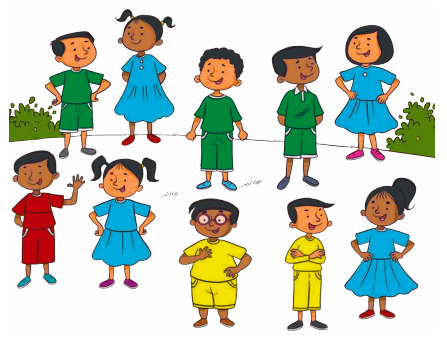
Let us Do
Look at the picture. Complete the table and fill in the blanks.

Ans:

A. The most liked colour is ______________________.
Ans: Blue
B. The least liked colour is ______________________.
Ans: Red
C. Yellow colour is liked more than ______________________.
Ans: yellow colour is liked more than Red colour.
D. ____________________ colour is liked more than green.
Ans: Blue colour is liked more than green colour.
E. _______________ colour is liked less than _______________.
Ans: Yellow colour is liked less than green colour.
Picnic Day
Children are having a fruit party. They are eating their favourite fruits.
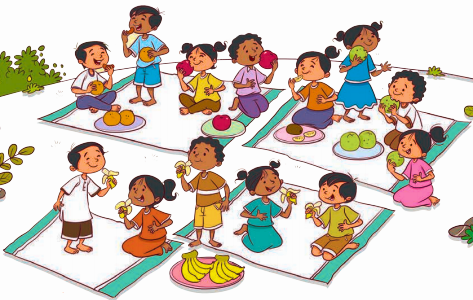
Let us Do
Complete the table and fill in the blanks.

Ans:

A. How many children are there in the picture? ____________.
Ans: 13 children were there in the given picture.
B. Number of children who like apples is _______________.
Ans: 2 children like apples.
C. Most liked fruit is _______________.
Ans: Bananas are the most liked fruit.
D. Least liked fruit is _______________.
Ans: Kiwi
E. Number of children who like guava is _______________ (more than/less than/equal to) the number of children who like apple.
Ans: Number of children who like guava is more than the number of children who like apple.
F. The number of children who like apple is _______________ (more than/less than/equal to) the number of children who like banana.
Ans: The number of children who like apple is less than the number of children who like banana.
G. The number of children who like orange _______________ (more than/less than/equal to) the number of children who like kiwi.
Ans: The number of children who like orange more than the number of children who like kiwi.
Discuss the picture and fill the table.
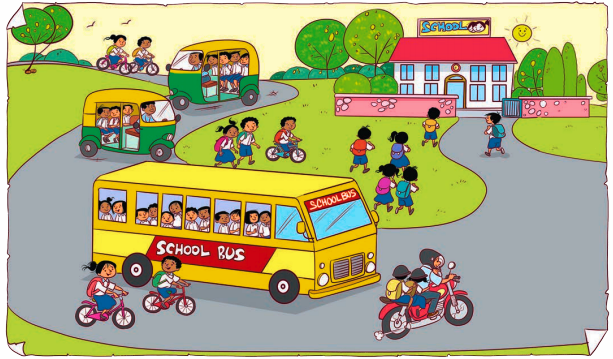

Ans:
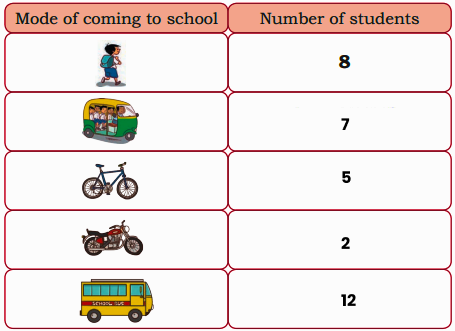
Read the table and draw faces (🙂) in the chart given below to show the number of students coming to school by different modes. ( 🙂= 1 student) Look at the chart and fill in the blanks.
Look at the chart and fill in the blanks.
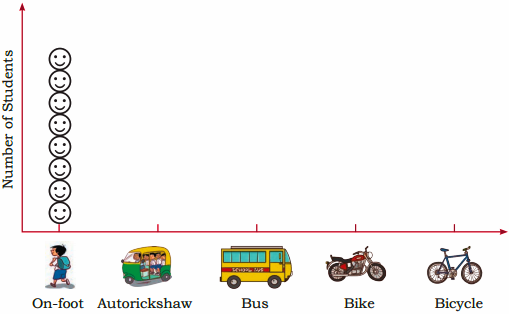
Ans:

A. Most number of students come to school by _________.
Ans: Most number of students come to school by bus.
B. Least number of students come to school by ________.
Ans: Least number of students come to school by Bike.
C. The number of students who come to school using bus is ________________ (less/more) than the number of students who come using autorickshaw.
Ans: The number of students who come to school using bus is more than the number of students who come using autorickshaw.
D. The number of students who come to school using bike is _________ (more/less) than the number of students who come using bicycle.
Ans: The number of students who come to school using bike is less than the number of students who come using bicycle.
E. The number of students who come to school using ________ is less than the number of students who come using _________.
Ans: The number of students who come to school using Bicycle is less than the number of students who come using on-foot.
F. The number of students who come to school using ____________ is more than the number of students who come using ________________.
Ans: The number of students who come to school using AutoRickshaw is more than the number of students who come using Bike.
Games we Play
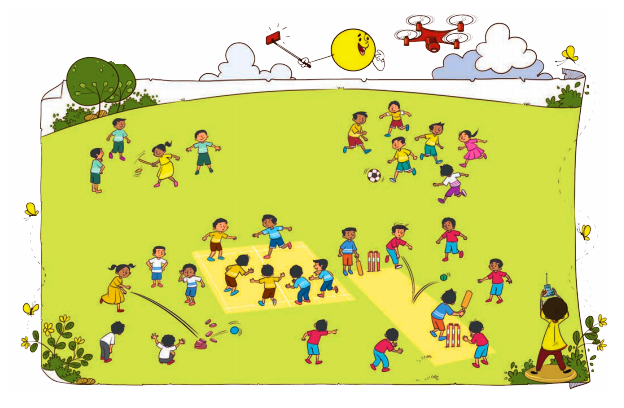
Let us Do
Look at the picture and fill the table.
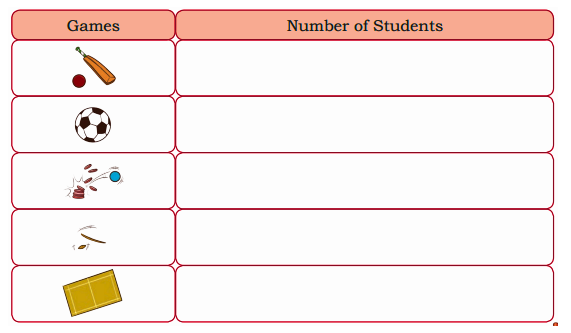
Ans:

Use the table to draw faces (🙂) to show the number of students in the chart below.
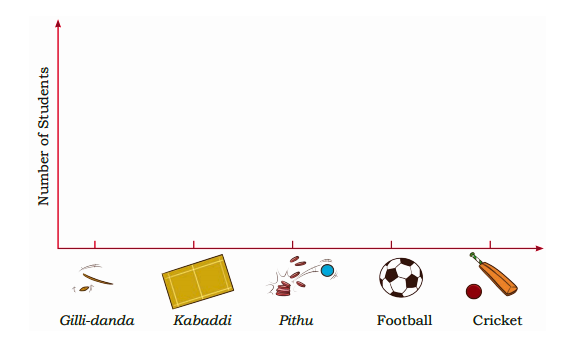
Ans:
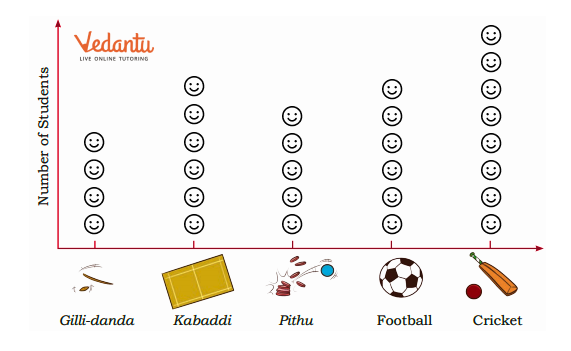
A. The most liked game is _____________________.
Ans: The most liked game is cricket.
B. The least liked game is _____________________.
Ans: The least liked game is Gilli-danda.
C. Pithu is liked more than _______________.
Ans: Pithu is liked more than Gilli-danda.
D. ___________________ is liked more than football.
Ans: Cricket is liked more than football.
Let us Do
A. Discuss in your class and ask your friends about the vegetables they like the most. Complete the table.

Ans:

B. Read the table and fill in the blanks.
i. Most liked vegetable is _________.
Ans: Most liked vegetable is Potato.
ii. Least liked vegetable is _________.
Ans: Least liked vegetable is Pumpkin.
iii. _________ is liked more than _________.
Ans: Lady finger is liked more than carrot.
iv. _________ is liked less than _________.
Ans: Pumpkin is liked less than carrot.
C. Ask your friends about the number of family members living in their homes. Fill in the table given below.

Ans:
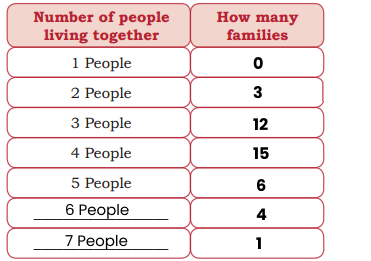
i. Most families have ______ people in their homes.
Ans: Most families have 4 people in their homes.
ii. The least number of people living in a home is ______.
Ans: The least number of people living in a home is 2.
iii. The number of families having 4 people is ______.
Ans: The number of families having 4 people is 15.
iv. The number of families having more than 4 people is ______.
Ans: The number of families having more than 4 people is 11.
Puzzles
A. Draw lines to connect each pair of similar shapes together. The lines must not cross or touch each other and do not use diagonal lines.

Ans:

B. Complete the pattern.

Ans:

C. Think and complete.
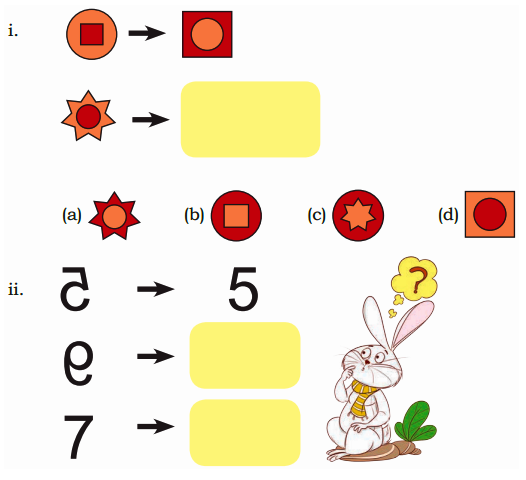
Ans:
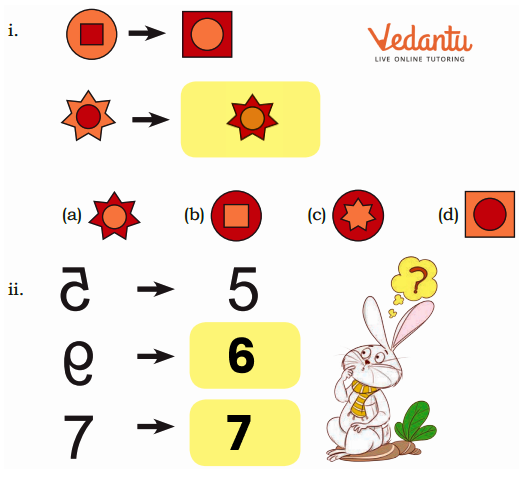
E. Look at the picture. How many different ways can the ant return to its home (anthill)?
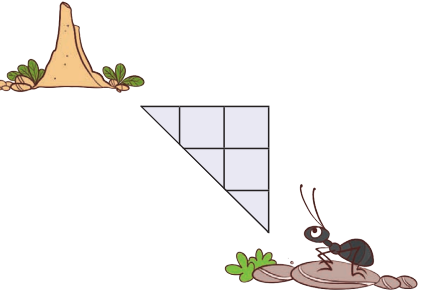
Ans:

Therefore, there are 3 ways that ant can return its home.
F. Find the number names from 11 to 20.
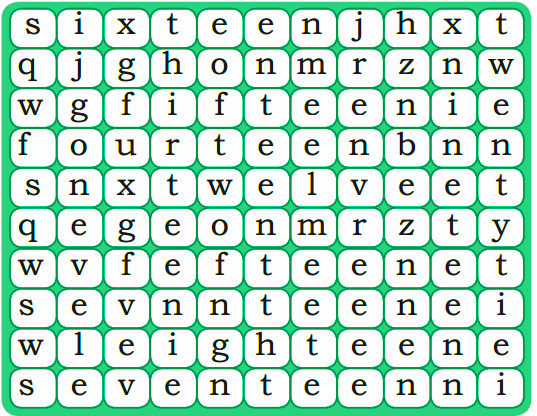
Ans:

G. Identify the appropriate shadow image.

Ans:

H. In how many different ways can the cat return to its house?

Ans: In 3 ways the cat can return to its house.
I. Try to make two squares by removing two matchsticks.
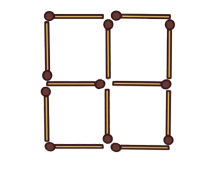
Ans:

J. Who am I?
I am in a bicycle,
And in a car and a bus,
I make all vehicles run,
They can’t move if I am flat.
What is my shape?
Ans: Circle or Tyre
K. Which balls will you select to make a total of 30?
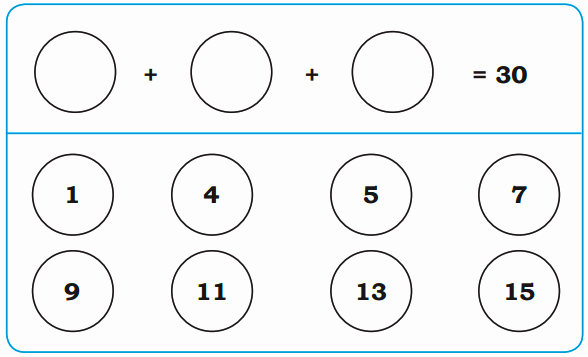
Ans:
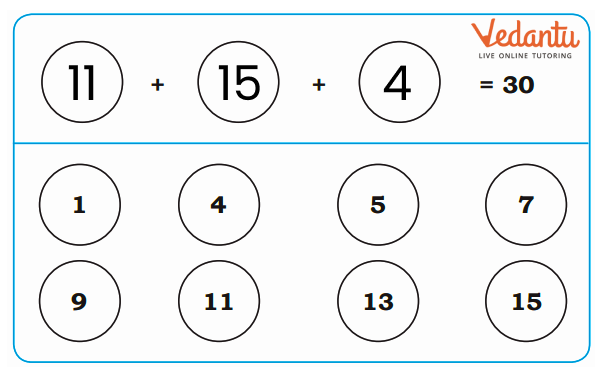
L. Make two different two-digit numbers by using only one digit.
Ans: By using digit 9 we can make two-digit numbers.

M. Draw a path so that hungry giraffe can reach the tree.
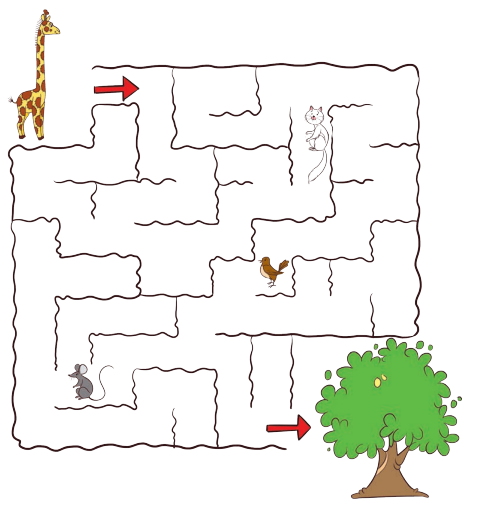
Ans:
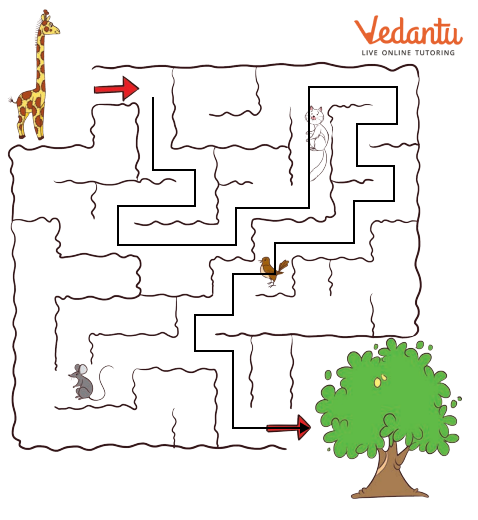
N. Look at the above picture and write the answers.
i. Name the animal whom giraffe met first on the path? _________________________
Ans: Giraffe met cat first on the path.
ii. Name the animal whom giraffe met in the last? ________________________
Ans: Giraffe met Bird in the last.
iii. Have you ever lost your way to home? _________________________
Ans: No
O. How many rectangles can be made after joining the dots given below?
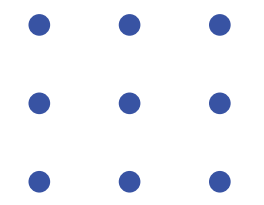
Hint: Square is also a type of rectangle.
Ans: We can make 9 rectangles.

P. Complete these by using addition or subtraction of numbers.

Ans:

Q. A shepherd has 4 sheep and 4 dogs. Divide the garden into 4 areas, such that each portion or area contains one tree, one sheep and one dog.
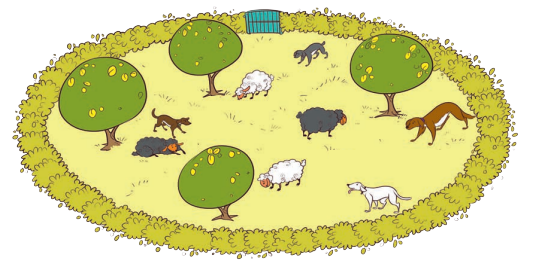
Ans:

R. Who am I? (A mirror can help you)
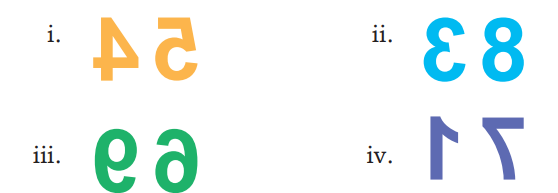
Ans:

S. How will you arrange the numbers 1 to 7 so that the three arms have the same total?
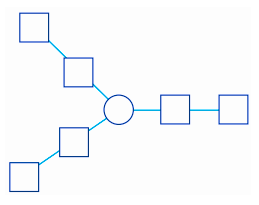
Ans:

T. Let us divide a 6 meter long cloth into pieces. If one meter is cut every time, how many times should we cut it?
Ans: 5 times

U. I think of a number and double it. If my answer is 18, then what was the number?
Ans: The number is 9.
V. Press 10 keys on a calculator to make 28.
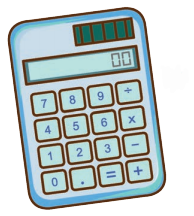
Ans: 9 + 8 + 7 + 3 + 1 = 28
Therefore, the 10 keys are 9, 8, 7, 3, 1
Benefits of NCERT Solutions for Class 2 Maths Chapter 11 Data Handling
From NCERT Solutions for Class 2 Maths Chapter 11 students learn to collect, organise, and interpret data through simple and fun methods, making abstract concepts easier to grasp.
This chapter helps students develop practical skills in using tally marks, lists, and basic graphs to represent and analyse information.
It provides practice exercises that reinforce data handling skills and build confidence in solving related problems.
With these solutions students can improve their ability to analyse and interpret data, which supports their overall problem-solving skills.
The chapter Data handling prepares students for more advanced data handling concepts in higher grades by building early familiarity with data organisation and representation.
Important Study Material Links for Maths Class 2 Chapter 11 Data Handling
S. No | Important Study Material Links for Class 2 Chapter 11 |
1. | Class 2 Maths Data Handling Important Questions |
2. | Class 2 Maths Data Handling Revision Notes |
Conclusion
The NCERT solutions for Class 2 Maths Chapter 11 Data Handling by Vedantu offer a clear and engaging way to learn data handling. By practising with these solutions, students gain essential skills in collecting, organising, and interpreting data, laying a strong foundation for future maths topics. These solutions make learning enjoyable and help build confidence, preparing students well for their exams and everyday problem-solving.
Chapter-wise NCERT Solutions Class 2 Maths - Joyful-Mathematics
After familiarising yourself with the Class 2 Maths Chapter 11 Question Answers, you can access comprehensive NCERT Solutions from all Maths Class 2 Joyful-Mathematics textbook chapters.
S. No | Class 2 Maths Chapter-wise Links for NCERT Solutions |
1. | |
2. | |
3. | |
4. | |
5. | |
6. | |
7. | |
8. | |
9. | |
10. |
Related Important Links for Maths Class 2
Along with this, students can also download additional study materials provided by Vedantu for Maths Class 2 –
S. No | Important Links for Class 2 Maths |
1. | |
2. | |
3. | |
4. | Class 2 Maths Revision Notes |
5. | Class 2 Maths Important Questions |






















